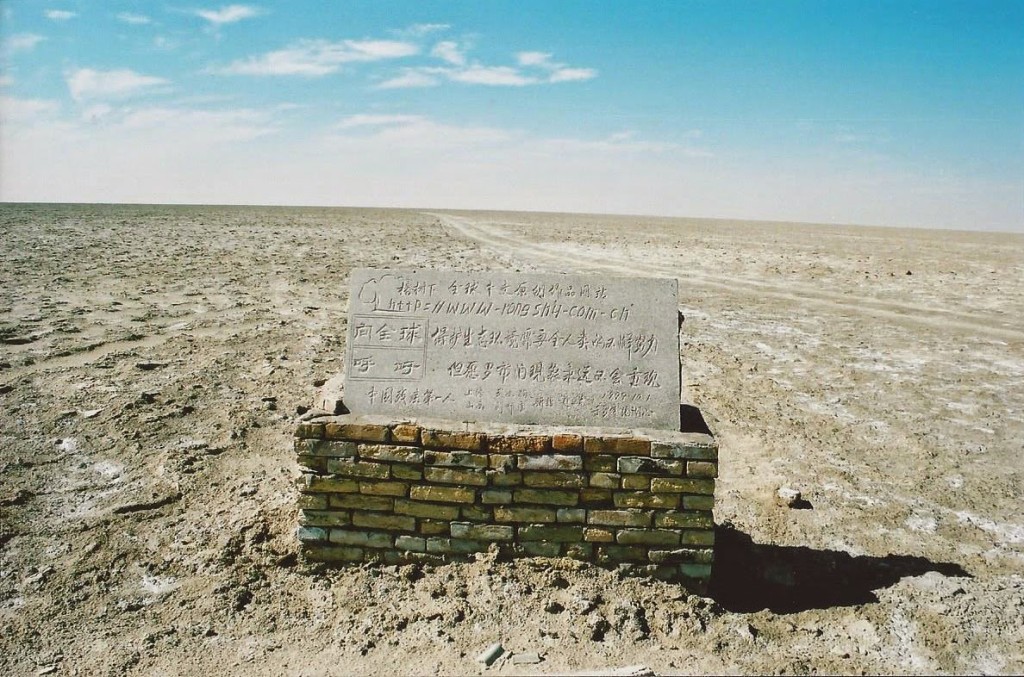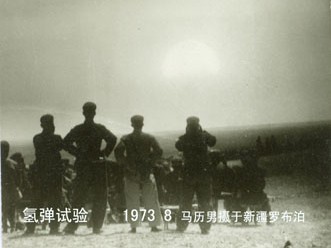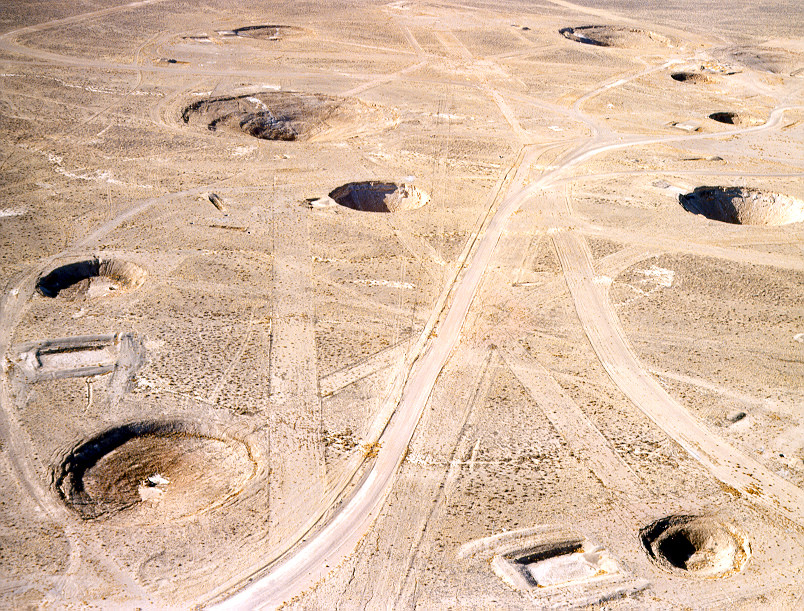“This ‘laboratory of death’ has strong negative effects not only on Xinjiang, but on the whole of Central Asia.” (Ilieva/Chasnikov)
av Ursula Gelis
I work for the rights and needs of victims of nuclear weapons explosions and nuclear testing. My partners are in Kazakhstan and other states, affected by the long-term effects of nuclear weapons testing. At the Vienna Conference on the Humanitarian Impact of Nuclear Weapons in December 2014, I interviewed an anti-nuclear activist, founder of the Lop-Nor Project and surgeon from China. “All Chinese nuclear tests were conducted at LOP NOR, in the desert area of Xinjiang Uighur Autonomous Region (North West China) in Central Asia. The first test was carried out in October 1964. The largest-scale nuclear explosion was caused by the hydrogen bomb test conducted in November 1976, with the yield of 4 Mt, equivalent to 270 times of the Hiroshima atomic bomb.”[1]
“We always say ‘Lop Nor’ but in reality the nuclear testing site is not located at Lop Nor, it is far more to the northwest […] The actual distance of Ground Zero, the bomb test site, to Lop Nor is 230 km. […] The military base is 217 km away from Lop Nor, which is far more distant from the test site than our residential areas! […] Today, Lop Nor is a tourist site and the Chinese government is saying ‘our test site is safe’. That is a lie, because the test site is not at Lop Nor!” Dr. Enver Tohti, Uighur surgeon and independent researcher in his speech at the European Parliament, 29th February 2012. “The last test took place in 1996. People, living around the former nuclear test site are struggling with the long-term effects of nuclear testing, not sufficiently addressed by China”. Tohti.
Enver Tohti (aged 52) was born in Hami, a city in the North West of China. In Uighur it’s called Komul. For Uighurs, the region is East-Turkestan, the Chinese call it Xinjiang. Tohti’s hometown is 200 kilometers north from the former nuclear test site. When Enver was a school boy, nuclear testing was a common subject. “We heard it every day from Chinese children because their fathers were regular employees at the test site. These people left their children at the capital city of Urumqi. The children were proud that their fathers were working with the atomic bomb. The propaganda emphasized the achievements of the government to have its own nuclear weapons program. «We were all brainwashed. Even me, a Uighur, I was proud of being a Chinese. We had the bomb! None of us had the slightest idea about radiation effects, resulting from nuclear weapons testing.”
Mao was in favor of an independent Chinese nuclear weapons program in order to be respected by other nations. “As a nuclear weapon state, everybody will listen to us!” Many people like Enver’s parents worked with the construction of a special railway to the test site. Transport from and to the Lop Nor test site passed through Enver’s hometown.
An earthquake! No, only another nuclear weapons test!”
Earthquakes regularly rocked the area and Enver recalls many shaky moments. The Partial Nuclear Test Ban Treaty came into force in 1963, advocating an end to above ground nuclear explosions. The Chinese started their testing program a year later. “Until 1996 the communist leadership conducted 22 underground, 23 above ground. In 1966, a Chinese propaganda film conveyed the message that testing will not inflict harm on people”.
«The region was in total an experimental field for warfare». In his speech at the European Parliament in 2012, Enver refers to the Kazakh scientist Kanatjan Alibekov, now better known as Dr. Ken Alibek, a crucial person in former Biopreparat. This was the Soviet Union’s biological weapon program. In his book Biohazard, (1999) Alibek talks about a “bio-containment lab close to the nuclear testing ground. [….] Unknown diseases [were detected].” Alibek’s team concluded that “Chinese scientists were weaponizing viral diseases”.
Apparently, a leak of biological weapons had caused two epidemics in northwestern China. Military facilities, known for their lack of transparency, often host secret operations beyond the reach of state law. Nuclear test sites are always situated in areas with disadvantaged populations, often minorities or indigenous people. Racism and colonialism, beside militarism, provide the platform for nuclear testing.
The ’101 – project’
According to Enver, the Lop Nor test site is 100 000 square kilometers wide. “It is a restricted military area until today. Bomb manufacturing took place in inner China, at several secret locations and only for testing the weapons were transported to Lop Nor. One name for the program was ‘101’-project, the code name for the railway build for the testing base. They had code names for each individual test. ‘Mission 21’, for example, is the code name for the first nuclear test.”
In the 1960s, the USSR notified China that it would not transfer the nuclear bomb construction technology to China. However, within 5 years, the country managed to build the ‘Peoples bomb’. (See: (U.Z.Ilieva, I.Ya.Chasnikov. What do we know about Lobnor, Almaty, 1997, p. 9).
Activism
“In 1995 I became an activist”, Enver says, “I used to work as a cancer surgeon at the Central railway bureau hospital, in a region of 20 million inhabitants. I could witness the growing number of cancer patients. Our cancer facilities could not offer sufficient treatment to so many people. I asked myself why we have such an increase in leukemia, lung and thyroid cancer and malignant lymphoma.”
“Lymphomas are a group of cancers in which cells of the lymphatic system become abnormal and start to grow uncontrollably. Because there is lymph tissue in many parts of the body, lymphomas can start in almost any organ of the body”.
“I consulted my textbooks looking for what those cancer types had in common. I found that all of them could be initiated by radiation. I made the link about radiation release from testing to the health problems of my patients”.
Small populations lived around the test site: Uighurs, Chinese, Kazakhs, and another 11 different ethnicities. The Kazakhs suffered two waves of prolonged devastation from the radiation of Cold War nuclear weapon testing programs; from the former Soviet nuclear test site (SNTS) near Semipalatinsk and from Chinese testing.
“From the very beginning of the nuclear tests at the Lop Nor test site, physicists of the Kazakh National State University […] near Almaty, sent weather balloons to high altitudes in order to detect the level of radioactive radiation regularly. Mostly all radioactive clouds, which appeared as the result of nuclear explosions in [the] atmosphere at the Lop Nor test site, passed over Almaty.”
Under Soviet rule the Kazakh scientists could not expect to receive useful information from the military in Kurshatov, the scientific center of the Soviet nuclear testing program, adjunct to SNTS. Almaty is closer to Lop Nor than to Semipalatinsk and the fact that also radioactive particles were also detected in Kyrgystan, supported the scientific view that fall-out from China was the cause of contamination in Southern Kazakhstan.
“Also Chinese civilians were not protected! By the way, soldiers received compensation for exposure to nuclear fall-out but civilians not,” Enver emphasizes.
The following is the direct transcript of the rest of our conversation:
«The Chinese government admitted that military personal was eligible to compensation. In1964, guidelines for compensation were issued two months after the first nuclear weapon test. Apparently the military knew that they put the whole region at risk.
I felt the need to inform people in the world what is going on here in my home province. Within China open talks about our problems connected to nuclear testing are impossible. The topic is a state secret.
In my hospital I became a senior consultant and had to improve my foreign language capabilities. I learned that Turkish would be a good additional asset and so I ended up studying in Istanbul. For us Uighurs, Turkish is not the most difficult language.
At the Bosporus, I happen to meet people from the British Channel No. 4 and they were curious to know what happened in the Lop Nor region. They asked me to accompany them to North West China to make a documentary about the testing program and the status quo of the region. This was in 1998. 
In July 1998, we spent 6 weeks in Xinjiang, they in the disguise of tourists and I as their guide. We managed to get hold of documents proving that the cancer rate became twice as high between 1990 and the year 2000. In fact, the rate is four times higher than Chinese national average.
I know that I had to leave the country before the documentary would be available. So I applied for refugee status in Turkey. I received the status within a month. I was asked to stay in Turkey for about a year waiting for being relocation afterwards.
Unfortunately the Chinese prime minister visited Turkey in that period and a Taiwanese journalist made me aware that I might face problems, if the Chinese diplomat would sign an extradition treaty with Ankara.
So I decided to leave Turkey as soon as possible. Living in the UK seemed reasonable, because the British journalists could clarify why the Chinese government wants to gain control over me. By that time I was already worked as a surgeon in Turkey. That apparently helped that the British embassy immediately issued a visa to the UK. Since then I am in a way stuck in Britain.
In China, every province has a state run cancer hospital. Again, it is a region of approximately 20 million people.
To compare the province with another region: In Henan province, 100 million people are living. The cancer hospital there was established in 1997 with 500 beds. Until 2008, the capacities expended to 800 beds only. Our hospital in Xinjiang, opened in the same year, starting with the same amount of cancer treatment facilities, expended to 2000 beds until 2008.
So 2000 beds for a population of 20 million people, and 800 beds for 100 million is a clear indication for the urgent need for more cancer treatment facilities.
There is another issue of great concern for me. Taiwan is dumping its nuclear waste at Lop Nor. We do not know how the transport to the former test site is organized but this is happening today.
I have evidence that until 2006, China issued 16 documents dealing with compensation of nuclear veterans but nothing is in place to help civilian victims.
My focus is on enhancing stability in the local region by forcing the Chinese government to pay compensation to the suffering locals for the health effects from nuclear testing. The health conditions of local communities have to be improved by applying for aid from China. International donors have to step in too. Free medical care for the victims of nuclear testing should be guaranteed.
There is still not enough knowledge in the world about the Chinese nuclear weapons testing program. The international community has the right to know about the health and environmental impacts of more than 30 years of Chinese nuclear weapons testing in Xinjiang.
We have to investigate and research the effects of the testing program on the region’s people and the environment. The findings need to be published in national and international media in order to raise awareness about this neglected issue.
Political pressure on the Peoples Republic of China (PRC) is necessary to give the innocent victims of nuclear testing the voice and practical help they deserve. The PRC is called upon to take action!»
[1] UN exhibition on global nuclear testing (NPT 2015). Organized by Japan Confederation of A – and H-Bomb sufferers organizations (Nihon Hidankyo) in collaboration with the cities of Hiroshima and Nagasaki, ODA and the Permanent Mission of Japan to the UN. (May 2015).


